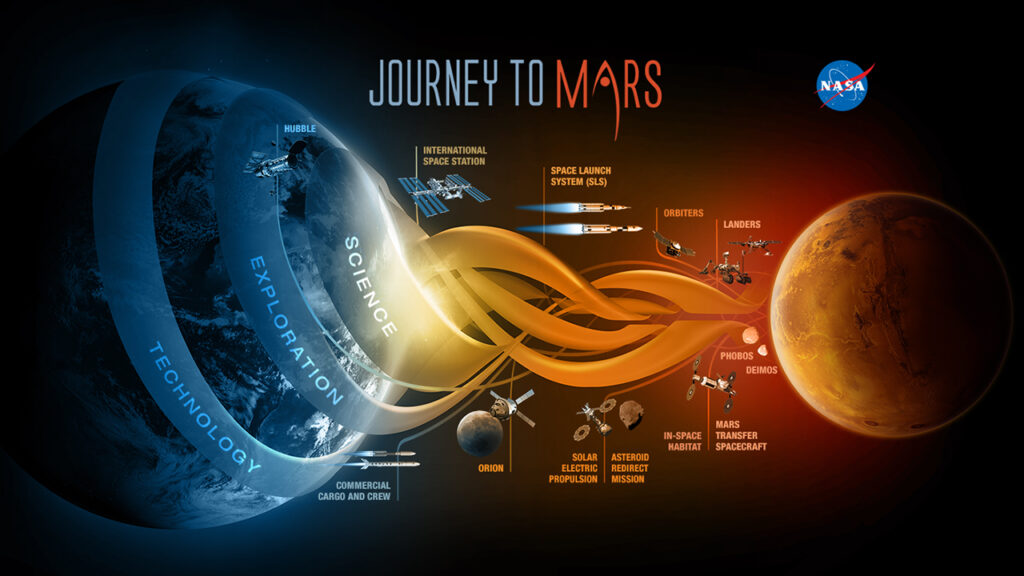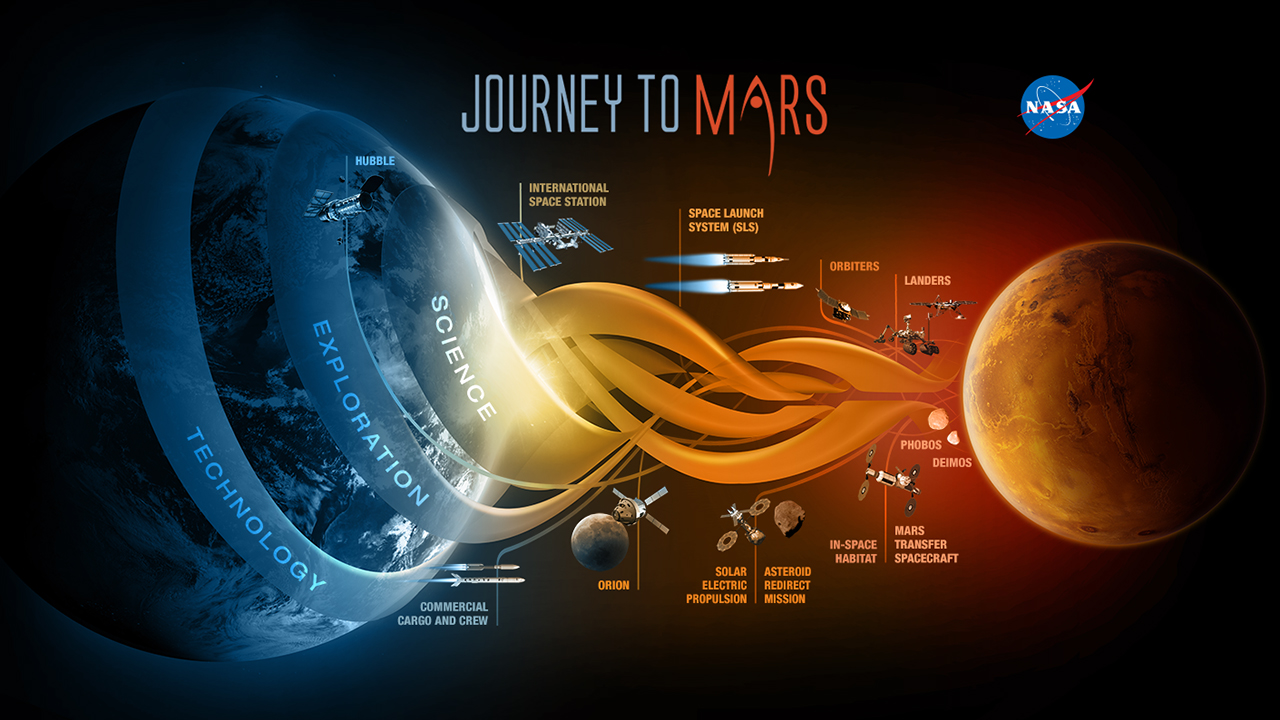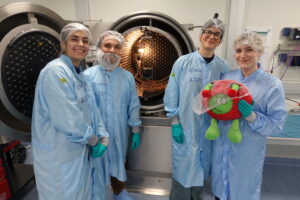Dear Space lovers, in May’s edition of our Newsletters, we posted an article regarding the first-time-ever creation of water on the surface of Mars. We try our best to emphasize the importance of Mars in the domain of space exploration and space missions. But why Mars? The answer is pretty simple: Mars is a valuable place for exploration because one can reach Mars in six and a half months, is a significant opportunity for scientific investigation, and has been mapped and studied for several decades. Mars is believed to be a world once rich in water and perhaps, in life, presenting an exciting partner to Earth. Any Mars mission represents the first step in a long-term effort to bring Martian samples to Earth and analyze them for buildups of microbial life. Beyond the study of life itself, there are several different benefits of Mars exploration.
Understand the origins and ubiquity of life
The site where rockets are targeted to land is where experts believe 3.5 billion years ago held a lake filled with water and flowing rivers. It is an ideal place to search for the residues of microbial life, test new technologies, and lay the groundwork for human exploration down the road.
Develop new technologies
Space exploration required scientists to learn how to communicate across vast distances, develop precise navigational tools, store, transmit, and process a lot of data, deal with health issues through digital imaging and telemedicine, and develop collaborative tools that link scientists worldwide. Going to Mars requires comparative inventiveness. Scientists have had to figure out how to search for life in ancient rocks, drill for rock samples, take high-resolution videos, develop flying machines in a place with gravity 40 per cent lower than Earth. They had to work and improve on sending detailed information back to Earth on time and take off from another planet.
Encourage space tourism
In the not-too-distant future, wealthy tourists likely will take trips around the Earth, visit space stations, orbit the Moon, and perhaps even take trips around Mars. Speaking of which, it might have reminded you of the space blog we posted in April on ‘Space Tourism’ where we asked you – if ever in your life you have dreamt of spending your future trips/ holidays on Mars!? Remember? Just in case you don’t! The article is here for you.
The advent of space tourism will broaden human horizons in the same way international travel has exposed people to other lands and perspectives. It will show them that the Earth has a delicate ecosystem that deserves protecting and why it is essential for people of different countries to work together to solve global problems. Astronauts who have had this experience say it has altered their viewpoints and profoundly impacted their way of thinking.
That’s not just all! Of course, investing years and hard work towards a deeper exploration of Mars will advance our current version of the Science and Technology set and help enhance space mining as well.
Since 1960, humanity has launched numerous missions to Mars to study neighbouring planets. Since the first successful flyby in 1965, four space agencies have successfully made it to Mars: NASA, the former Soviet Union space program, the European Space Agency, and the Indian Space Research Organization, while others, including the space agencies in Russia, Japan, and China, have attempted Mars or Martian moon missions without success.

The latest batch of Mars-bound missions in February 2021 was:
- NASA’s Perseverance rover aimed to search for past life on Mars and store samples for future return to Earth.
- Ingenuity helicopter: it’s a technology demonstration to test powered, controlled flight on another world for the first time. So, the primary goal is to see if we can fly on Mars. On April 19, 2021, it completed the first powered, controlled flight by an aircraft on a planet besides Earth, taking off vertically, hovering, and landing for a flight duration of 39.1 seconds.
Ingenuity helicopter brings to mind and, of which we feel proud to announce right now is – a fascinating upcoming seminar – “Ingenuity – The Mars Helicopter mission and Mars exploration through aerial vehicles“ organized by the PoliSpace going to be held on October 19– 2021.
Abstract: Ingenuity completed its primary mission by achieving several 90-second flights and demonstrating the feasibility of heavier-than-air flights on Mars. The Mars Helicopter’s excellent performance and success encouraged NASA to extend its mission to assist the Perseverance rover team by providing increased imaging and navigation capability. As it gets harder for Ingenuity to operate on Mars with the seasons changing, the mission continues to unveil the potential of Mars exploration through aerial vehicles.
Bio: Stefano Cappucci has a BSc and an MSc in Aerospace Engineering from Polytechnic of Turin. He is a thermal fluid system engineer at NASA Jet Propulsion Laboratory. Stefano started at JPL in 2017 and has worked on different NASA flight projects such as Mars2020, NISAR, and the Mars Helicopter. He is also part of the thermal technology team at JPL, focusing on thermal technology advancement for space exploration. He is currently Thermal System Lead for the Mars Helicopter mission.
REGISTRATIONS WILL OPEN SOON HERE
- United Arab Emirates’ Hope orbiter: it aimed at producing an entire picture of Mars’ climate.
- China’s Tianwen-1 orbital and lander-rover mission aimed to search for water pockets beneath the surface that could host life.
As of this update, none of the 2021 missions have arrived at the Red Planet yet. Well, to have a look at all of the Martian missions in history would be pretty time-consuming. Instead, it’s better to be aware of future missions to Mars.
Here is a list of some of the most critical future Mars missions:
- ExoMars Rosalind Franklin
The ExoMars program is a pair of missions, led collaboratively by the European Space Agency and the Roscosmos State Corporation, designed to understand if life existed on Mars. This particular ExoMars mission will send a rover named “Rosalind Franklin” to Mars to search for past and present life signs. It is planned to launch in Kazakhstan between August and October of 2022 from the Baikonur launch complex and land on Mars roughly nine months later.
- Mars Sample Return, an international project to bring Mars to Earth
The Mars Sample Return Campaign is an effort to bring samples of Martian rocks and soil back to Earth, where they can be investigated in unprecedented detail, using all the capabilities of terrestrial laboratories. It is part of NASA’s Mars Exploration Program, a long-term effort of robotic exploration of the Red Planet. NASA collaborates with its various centers and the European Space Agency (ESA) to develop the advanced technologies and hardware needed for the campaign.
It is planned to launch the lander in 2026 that will arrive at Mars in 2028, close to the Mars 2020 rover near Jezero Crater. It deposits the fetch rover, provided by ESA, on Mars to pick up the stashed samples and transfer them to the rocket. Once the pieces are on our home planet, scientists plan to conduct detailed chemical and physical analysis in laboratories worldwide to look for signs of past life on Mars and perform many other studies beyond the capabilities of instruments delivered to Mars.
- Martian Moons eXploration (MMX)
MMX’s mission is to explore the two moons of Mars, with a planned launch in the mid-2020s. Approximately one year after leaving Earth, the shuttle will show up in Martian space and circle Mars. It will then move into a Quasi Satellite Orbit (QSO) around the Martian moon, Phobos, to collect scientific data and gather a sample from the Moon’s surface. After observation and sample collection, the shuttle will return to Earth, conveying the material gathered from Phobos. The current schedule has a launch date in JFY 2024, followed by Martian orbit insertion in JFY 2025, and the spacecraft will return to Earth in JFY 2029.
Exploration of the Martian moons will help improve technology for the future planet and satellite exploration. For example, the advancement in the technology required to make round-trips between the Earth and Mars, the advanced sampling techniques employed on the Martian moon surface, and the optimal communication technology using the Deep Space Network ground stations.
Upcoming seminar by Paolo Bellutta (To be held on November 7, 2021)
Abstract: Have you ever wondered – how it is possible to send and operate robotic vehicles on another planet that is so far that just communicating between Earth and your spacecraft can take more than half an hour? The Jet Propulsion Laboratory in Pasadena, CA’s sole purpose is to develop, design, build and operate robotic spacecraft to explore our Solar System. This interactive talk will cover some of the challenges that arise from exploring our planetary neighbor, Mars using rovers, landers, and orbiters, and how engineers and scientists cooperate and respond to challenges and anomalies.
Bio: Paolo Bellutta, born and raised in Italy, has operated the rovers Spirit, Opportunity, and Curiosity for 15 years. He has worked on many different projects at JPL since 1999, developing machine vision algorithms for robotic vehicles for use on Mars and Earth. He previously developed vision algorithms for various applications.
REGISTRATIONS ALREADY OPEN HERE
We believe, being Space lovers, you have in you this curiosity to know the answers to all such questions, well, then we are looking forward to seeing you in the seminars as mentioned earlier.





